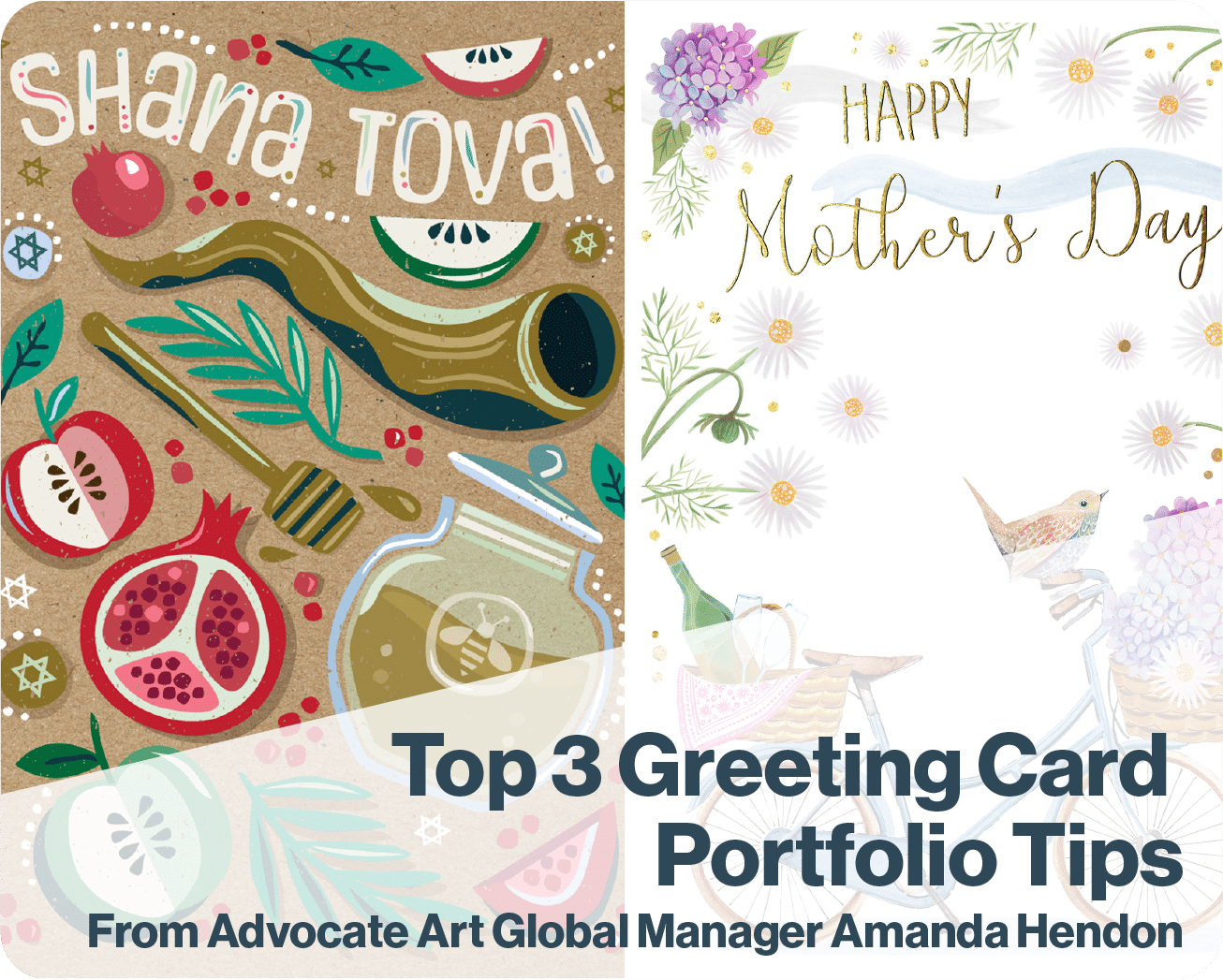Top 3 Greeting Card Portfolio Tips
Published on 19/03/2024Greeting Card designs by Advocate Art illustrators Amanda Shufflebotham, Kathryn Selbert, and Victoria Nelson.
Top 3 Greeting Card Portfolio Tips
Teacher: Amanda Hendon, Advocate Art Global Manager
Today, we are sharing Advocate Art’s Top 3 Tips for Greeting Card Illustration. These tips come directly from Advocate’s Global Manager Amanda Hendon. Amanda has been working in the greeting card industry for over six years with clients such as American Greetings and Hallmark. These tips come from her years of experience working with clients and helping artists develop their greeting card portfolios.
1. Play to your strengths
It seems like an obvious thing to say, but knowing your own strengths as an artist and greeting card designer is integral, and similarly, making the most of those strengths. If you’ve had clients love your beautiful watercolor flowers for Mother’s Day cards, it certainly doesn’t hurt to make more of them! Of course, you don’t want to pigeon hole yourself, but if you’ve had a design sell well and have many clients ask after it, it behooves you to make more similar designs. To summarize: explore and create new designs, but know that you don’t always need to reinvent the wheel – if you’re a watercolor artist, you don’t also need to become a master of vector art.
2. Explore less popular occasions
Whilst a well designed birthday design will usually sell, it’s also important to keep in mind there are many underserved occasions in the greetings world, and because of that, clients have a very hard time finding relevant designs. These occasions would include: Chinese New Year, Diwali, St. Patrick’s Day, Hanukkah and Rosh Hashanah, Baptism, Communion, and Confirmation, and in general any design for a masculine buyer. Because there’s a general lack of designs for these occasions, making a few designs or a range for them means you have a higher chance for a sale – there’s simply less competition.
3. Keep on top of current trends
The greeting card market has it’s tried and true’s (you can always rely on bunnies for Easter, for example), but it’s important to be aware of what’s trending in the greetings world and pop culture at large. Greeting cards pull their trends from the worlds of fashion, home decor, and even viral trends; so if you see on TikTok and Instagram an explosion of frog memes, it wouldn’t be a bad idea to work a frog into a card or two! Whilst designs should always primarily reflect icons and motifs for their occasion (Birthday cards and cake, for example), you can work in trendy aspects through message carriers, palettes, and additional trendy icons.
For more free tips for how to improve your illustration portfolio, subscribe to our ITSme Learning Newsletter!
Other News
Why Every Illustrator Portfolio Needs a Stand-Out Character (Yes, Even Yours)
When you’re thinking about our favourite stories as a child, we often think about the narrative, the themes, perhaps a particular quote that stood out, but the most memorable elements are always the characters. The reason the characters always stay in our minds is because they are the gateway to the narrative, and all of…
Trend Watch: YA Illustrated Covers
Over the past few years, illustrated covers have become a defining visual language in the Young Adult (YA) and New Adult (NA) book market. And no, this isn’t just a passing trend—it’s a design evolution powered by the viral force of #BookTok, #bookgirlies, and a growing appetite for genre-fluid storytelling. Hear what’s driving the…
Trend Watch: The Graphic Novel Boom
Every week we’ll be featuring a new article over on LinkedIn, in our new trend watch series! Graphic novels are having a moment—and it’s no passing trend. From classrooms to bestseller lists, graphic novels are dominating shelves and reading time across all ages. What was once seen as a niche format with a distinct, heavy-lined “comic book”…
Bologna 2025: A Week of Connection
By: Vicky Patoulioti, Talent Source Manager, ITSme This year’s Bologna Children’s Book Fair was one to remember. From early mornings to late evenings, our team Vicky, Bhavi, Ed, and Emily — were on the ground offering free portfolio reviews to artists from all over the world. Mornings kicked off with pre-scheduled reviews, while in the…
How to Beat AI and Catch the Client’s Eye
Illustration by Camipepe By: Edward Burns, CEO, ITSme As AI art tools become more sophisticated, it becomes more important to emphasize our value and status as authentic human artists. Crafting a great bio and portfolio is an excellent way to make an immediate impact. They should allow the client to get to know you in…
Be A Pro at Curating Your Portfolio!
You asked, and we listened! Be A Pro at Curating Your Portfolio; our new course is here! Learn all the secrets to crafting a standout portfolio with 4 Hours of Expert-Led Content! One of the biggest challenges you face in your illustration career is presenting your work in a way that catches the eye of…




